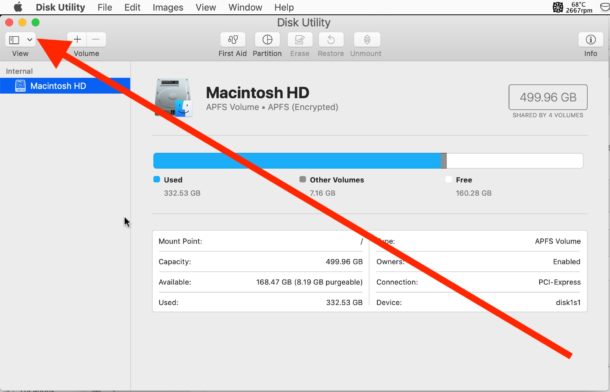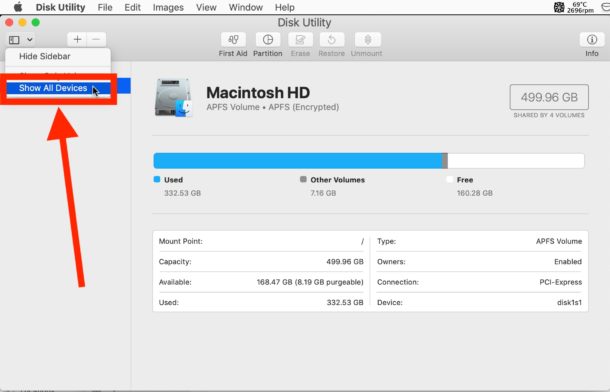How to Show All Drive Devices in Disk Utility for MacOS

You can adjust a setting in Disk Utility for Mac to see all device disks and drives connected to a Mac. This will make it so that you can view the containing drive (like “Apple SSD”) rather than simply the partition or volume that is accessible by the user facing part of the file system (like “Macintosh HD”).
How to Show All Drive Devices in Disk Utility on Mac
- Open Disk Utility on the Mac if you have not done so already
- Click on “View” in the toolbar
- Choose “Show All Devices”
- See the list of disk devices in the sidebar of Disk Utility



As mentioned a moment ago, this will allow you to see the parent drive containing whatever partitions or volumes that are accessed by the user. For example if you have a drive with a hardware name like “SAMSUNG SSD 1TB” that contains two APFS volumes called “Macintosh HD” and “Backup” then you would see all of that drive information hierarchically in Disk Utility, rather than simply the two named APFS volumes.
You can also access the different disk and volume views from the Disk Utility “View” menu.
Note this is only applicable to the newest versions of Disk Utility for the latest versions of MacOS. Earlier versions of Disk Utility in earlier Mac OS X releases were more full featured and displayed extended disk data immediately.
Disk Utility on the Mac will still not show some other volumes and partitions even with his setting enabled, for example the Recovery partition and EFI partitions will not be displayed through Disk Utility on the Mac in modern versions (and there is no longer a known Disk Utility Debug menu for advanced users to access either). Thus, if you’re an advanced user and wish to see all of those partitions you’d need to use the command line to list all drives, mounted drives, and partitions as shown here. You can also mount and unmount drives from the Mac command line and explore many other powerful options for the command line diskutil tool.


Why did Disk Utility on Catalina show Disk Sets for soft Raid 1 volumes and when I rebooted, I cannot see the Disk Sets any more. How come Disk Sets “disappeared” and why the means of showing them is not mentioned in this guide?
External USB disk does not show mounted in Desktop if not previously plugged before cold booting.
Disk Utility or Mountain or Terminal “diskutil list” command or “Apple – About This Mac – System Report – Hardware – Storage” do not show it. But shows on “Apple – About This Mac – System Report – Hardware – USB”.
Yet, the external USB disk shows if unplugged and plugged back again. Or if other external USB disk is plugged in other USB port (the latter sometimes requires several trials).
Once the external USB disk shows, it keeps on showing for such disk or any other plugged external USB disk, until the Mac is shutdown and cold booted again (for external USB disks not previously plugged before cold booting).
System: macOS 10.12.6 (16G2136) Sierra on iMac 27-inch 5K Retina (mid 2017; iMac18,3).
How to fix it? Thanks.
Fixed in macOS 11.3 (20E232) Big Sur and maybe earlier versions as well.
Update: well, mostly fixed most of the times, but sometimes arises again in macOS 11.4 (20F71) Big Sur.
The issue may also arise (of course) if the USB cable is loose (not well plugged) or defective. Now the issue has gone with macOS 11.6.1 (20G224) Big Sur.
Hi
my Disk Utility is “stuck” in the SHOW ALL DEVICES view and won’t toggle to the SHOW ONLY VOLUMES view.
It was ok earlier today but it has gone a bit funny now.
Earlier today when I clicked on the show only volumes it worked fine and removed the headings per drive so that it just read:
Macintosh HD …………… (ssd 1TB)
H First Backup …………… (HDD)Mac OS Extended (Journaled)
G Drive with Thunderbolt… (HDD)Mac OS Extended (Journaled)
Time Machine 1 ……………(ssd 1TB) ” ” ” ”
Any ideas why this should happen.
I am using 2017 iMac 27″ 5K .. Mojave OS.. 1TB ssd internal drive with 2 External HDD and a 1TB external SSD for Time Machine.
Is there a key that I may have pressed that has “locked” the view option to SHOW ALL DEVICES only?
This was very helpful except I can’t find the view option in my macOS Sierra . I’ve been trying for hours. The view option is visible for other applications but not for disk utility.i haven’t found anyone having this problem. Maybe I am the only one
it would be easy to have eg my iPhone also visible in this view. How can that be made visible?
That’s a neat idea but it is not possible, probably because iPhone is not treated as a disk by the operating system. It would be a cool feature for file storage but instead iCloud Drive must suffice.
FWIW, some Android phones can be used that way particularly when you use an SD card with an Android phone, but Apple does not offer that ability with iPhone or iPad.
You do not have to do anything, this is the default view on Mojave. Why does it even warrant an article?
Believe it or not, showing all devices is not the default view in MacOS Mojave for Disk Utility. Same applies to Catalina and probably going forward, as the interface for Disk Utility has been getting more simplified as time goes on.
This information is NOT correct for Mojave. I did a clean install just recently and upon completion, DU showed all volumes as the defaulted setting from this clean install.
I have a new Mac with Mojave shipped preinstalled and by default they do not show all devices in Disk Utility. Perhaps it depends on the underlying hardware.
Ultimately it doesn’t matter much though, because if you can see all of the devices in Disk Utility already, you wouldn’t need to know how to show all the devices because they’re already visible for you :)
then it was changed prior to you receiving the computer. I have done clean installs of Mojave, and like prior versions of OSX, the default view is always to show all drives.
I posted this once already but you chose to sensor it, lets see if you can accept you are wrong, and be professional and post this.
If you can already see all the drives and devices attached to a Mac through Disk Utility that’s great and you won’t need to make any adjustments, but for some others obviously the setting is different in Disk Utility. Maybe it depends on the Mac model, maybe it depends on the user, maybe it depends on the upgrade path, who knows exactly? There are many variables, but it doesn’t really matter as long as someone knows how to see all devices attached to their Mac through Disk Utility should they need to do so. So let’s stay on topic and try to add something fruitful to this discussion and focus on the bigger picture, otherwise we’re just filling comments with back-and-forth.
Hello Paul.
Every thing you offer is Great. I enjoy reading it But is is above my Mac Knowledge. All I know it is Machine language.
My Mac is 21.5 1977, Woks fine on iOS and Windows.
My problem is (like other Mac owner of this model is
that you can not run an Outside CD DVD DRIVE.
I have Phoned Apple and they say NO YOU CANT.
(to me, it does not make sens.)
At least I have a ASUS lap top to download CD DVD on a USB Key.
But keep up your good work and it HELP.
I am open to suggestion.
René